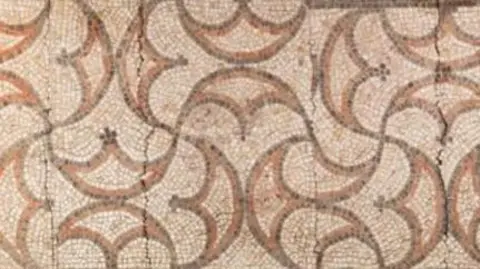'Unique' Roman mosaics at risk of leaving the UK
 Department for Culture, Media and Sport
Department for Culture, Media and SportA temporary export bar has been placed on two Roman mosaics considered at risk of leaving the UK.
The government's decision follows the advice of Arts Council England (ACE) and is to allow time for a UK museum, gallery or institution to acquire them.
The geometric mosaics were discovered at a Roman villa at Fullerton, Hampshire, in 1904, and together they are valued at £560,000.
Arts Minister Sir Chris Bryant said they provided "a rare insight into the local history of Hampshire during Roman Britain".
 Department for Culture, Media and Sport
Department for Culture, Media and SportThe villa was first discovered during excavation as part of a continuing exploration of the upper Test Valley.
In 1904, the mosaics were uncovered and moved to Fullerton Manor.
In 2022, archaeologist Barry Cunliffe confirmed they had come from the walkway that ran along the southern end of the villa.
One section was relaid in Fullerton Manor, the other is in Andover Museum.
They have been described as having "unique defining characteristics".
The first one, set at the recommended price of £380,000, shows what is believed to be a "running pelta" design, with crescent-shaped small shields arranged in a geometric pattern.
The second mosaic, recommended for the price of £180,000, shows geometric designs created with tiles of same colour scheme and background.
'Breathtaking beauty'
Sir Chris said he hoped a UK buyer could be found "so that the public can continue to have opportunities to learn about our country’s rich history and to enjoy these mosaics for generations to come".
Tim Pestell, member of the reviewing committee, said the survival of the two stretches of mosaic was "remarkable".
"Although many have been revealed through excavations in Britain, the number that survive intact is tiny," he said.
"The ways in which they were used, the trade networks exploited for their materials and above all, their breathtaking beauty can only be fully realised if these intricate pieces can be saved for the public by a museum."
The export bar will last until 19 February.
You can follow BBC Hampshire & Isle of Wight on Facebook, X (Twitter), or Instagram.
